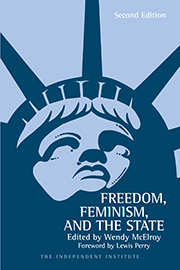The United States leads the world, by a large margin, in the production of at least one thing: prisoners. We have 25 percent of the world’s inmates, but just 5 percent of the world’s population.
Where do they come from? Well, since the Anti-Drug Abuse Act of 1986, the number of American inmates has risen from approximately 300,000 to a currently estimated 2.3 million. This statistic points to the role of drug-related victimless “crime” in creating prisoners.
There are other sources. The “private prison complex” is a creation of crony capitalism through which privileged corporations are paid well for the “care” of inmates and for leasing out prison labor to other businesses.
Ten percent of American prisons are now “privately” operated, for-profit businesses. Between 1990 and 2010, the number of for-profit prisons rose 1600 percent, far outpacing the growth of public ones or the population at large. The likelihood of being arrested is already higher in America than anywhere else in the world. That likelihood will rise if the financial incentives to imprison more people continue or increase.
“Private” Prisons Insult Real PrivatizationPrivatization involves a transfer of ownership and control from the State to a private entity; a post office or public lands are commonly used examples. In a free market, a privatized business competes for customer dollars without any legal advantages or other privileges. Under crony capitalism, the “privatized” business enjoys legal privileges and other advantages such as tax funding.
“Private” prisons are run by corporations to which government outsources the care of inmates. The corporation receives X tax dollars for each prisoner, quite apart from the actual cost of care. This builds in an incentive to skimp on services such as food and medical care. And, indeed, most prison contracts include a “low-crime tax” or “lock-up quota.” This system means taxpayers compensate the corporation for empty cells if the number of prisoners falls below a set quota. A recent report, “Criminal: How Lockup Quotas and ’Low-Crime Taxes’ Guarantee Profits for Private Prison Corporations,” found the average “occupancy guarantee” to be 90 percent; in four states, it is between 95 percent and 100 percent. Thus the “private” prison is guaranteed a tax-funded profit.
Prisoners’ labor is also leased out to government agencies or to major corporations. Prison labor reportedly produces 100 percent of military helmets, shirts, pants, tents, bags, canteens, and a variety of other equipment. Prison labor makes circuit boards for IBM, Texas Instruments, and Dell. Many McDonald’s uniforms are sewn by inmates. Other corporations—Microsoft, Victoria’s Secret, Boeing, Motorola, Compaq, Revlon, and Kmart—also benefit from prison labor.
The “private” prison industry is private in the same sense that crony capitalism is capitalist. Namely, not at all. It is the antithesis of a truly private industry that competes in the free market, does not accept tax funds, and cannot compel labor. By contrast, the “private” prisons enjoy a monopoly over a service that is created by laws and sentencing policies. They receive tax money and preferential treatment. They exploit captive labor through circumstances similar to plantation slavery.
In an article titled “The Prison Industry in the United States: Big Business or a New Form of Slavery?” (Dec. 8, 2013) by Global Research, the authors describe the advantages of leasing prison labor.
They don’t have to worry about strikes or paying unemployment insurance, vacations or comp time. All of their workers are full-time, and never arrive late or are absent because of family problems; moreover, if they don’t like the pay of 25 cents an hour and refuse to work, they are locked up in isolation cells. [Note: payment rates vary and are cited as high as $2 an hour.]
The beneficiaries of “private” prisons are the government entities that claim to save money through outsourcing, the politicians who facilitate the contracts, the “private” prison corporations, and the corporations who lease prison labor.
The victims of “private” prisons are the coerced workers and the true private sector, because the corporations that lease extremely cheap prison labor can undercut their competitors. The tractor-trailer division of Lufkin Industries in Texas provides a dramatic illustration. Its competitor, the Direct Trailer and Equipment Co., began to offer the same basic product for about $2,000 less than Lufkin. It could do so because it enjoyed both prison labor and state subsidies; for example, Direct Trailer paid a nominal fee ($1 a year) to use manufacturing facilities within the prison compound. Lufkin’s division went out of business, laying off 150 people because they could not outcompete prison labor.
Incentives to Increase the Prison PopulationLouisiana, too, is instructive. A Times-Picayune article, “Louisiana Is the World’s Prison Capital,” reported, “The state imprisons more of its people, per head, than any of its U.S. counterparts. First among Americans means first in the world. . . . The hidden engine behind the state’s well-oiled prison machine is cold, hard cash. A majority of Louisiana inmates are housed in for-profit facilities, which must be supplied with a constant influx of human beings or a $182 million industry will go bankrupt.”
One in 86 adults in Louisiana is doing time. The article hints at the reason: the entanglement of State and crony enterprise.
In a uniquely Louisiana twist, most prison entrepreneurs are rural sheriffs, who hold tremendous sway in remote parishes. . . . A good portion of Louisiana law enforcement is financed with dollars legally skimmed off the top of prison operations. If the inmate count dips, sheriffs bleed money. Their constituents lose jobs. The prison lobby ensures this does not happen by thwarting nearly every reform that could result in fewer people behind bars.
These and similar incentives have created “the prison-industrial complex.” In 2008, the human cost of the complex was starkly revealed in what was called the “kids for cash scandal.” The private prison company Mid-Atlantic Youth Services Corp. ran juvenile facilities in Pennsylvania. Two judges were found guilty of pocketing $2.6 million for sending approximately 2,000 children to the facilities. Even first-time offenders were given harsh sentences for trivial offenses such as mocking a principal on social media. Several hundred of the judges’ convictions were overturned. But expunging records could not help a traumatized child, a first-time offender, who committed suicide.
How Did “Private” Prisons Gain Such a Foothold?Corporations have a long history of providing specific services, such as food preparation, to prisons. This tradition stretches back to well before the drug war. During the early 1980s recession, prison overcrowding spiked and tax revenue declined, opening the door to expansion. In 1984, the Corrections Corporation of America (CCA) assumed total control of a Tennessee detention facility. This was the first such contract in the United States.
Prisons have continued to face the same dilemma: overcrowding, scarce funding, and employee cutbacks. The Times-Picayune describes Louisiana’s response: “In the early 1990s, when the incarceration rate was half what it is now, Louisiana was at a crossroads.” The state was court ordered to correct overcrowding. There were two choices: fewer inmates or more prisons. The state chose the latter by “encouraging sheriffs to foot the construction bills in return for future profits. The financial incentives were so sweet, and the corrections jobs so sought after, that new prisons sprouted up all over rural Louisiana.”
The inmate population has soared since.
BacklashA backlash is underway and some opponents speak with powerful voices.
For example, labor unions decry prison work. The pressure is having an effect. Some states, like Nevada, are considering legislation to require “oversight and transparency” for “private” prisons. Other states have been shaken by reports of cost-cutting measures taken by private prison corporations. The ACLU reported on one such prison in Ohio:
The compliance rating [with state standards] plummeted from the 97.3 percent compliance . . . when publicly-owned to 66.7 percent. Auditors found outrageous violations like prisoners being forced to use plastic bags for defecation and cups for urination because they had no running water for toilets. Basic conditions were heinous, with black mold, standing water, and spoiled food found throughout the prison. . . . [T]he medical department is grossly understaffed and many prisoners go untreated.
Meanwhile, the private prison complex is entrenched. It wields lobbying clout, as do the corporations that lease prison labor.
The large “private” prison corporation, the Corrections Corporation of America, is unabashed about its plans. The 2010 CCA Annual Report stated, “We believe we have been successful in increasing the number of residents [prisoners] in our care and continue to pursue a number of initiatives intended to further increase our occupancy and revenue.” Translated from corporate speak: They plan on nabbing many more people and locking them up.
ReformA giant step toward reducing overcrowding and the perceived need for outsourcing prisons would be to stop arresting non-violent “criminals.” Another big step would be to require criminals who damage or steal property to pay restitution to their victims rather than be punished by incarceration.
Unfortunately, there is no profit to the State nor to crony corporations in those solutions. In the foreseeable future, the prison population of America will grow, with minor infractions drawing lengthy jail terms.
Police states are the mother of prison complexes. Whatever solutions arise will come from shining the harsh light of reality upon both.
Reprinted with permission of the publisher. © Copyright 2014 Foundation for Economic Education









